Analyzing Communication Models and Conflict Management in Business
VerifiedAdded on 2023/06/16
|10
|2362
|359
Report
AI Summary
This report provides an overview of business communication, highlighting various communication models such as linear and transactional models, and different types of communication including vertical, horizontal, and diagonal. It elaborates on essential communication methods like visual, verbal, non-verbal, and written communication, emphasizing the skills required for effective business communication, such as writing, listening, and understanding body language. The report also addresses managing conflicts in the workplace, factors contributing to poor communication, and provides recommendations for improving communication within organizations. The importance of clear and effective communication in achieving business success and minimizing misunderstandings and conflicts among employees is underscored. Desklib provides access to solved assignments and study resources for students.
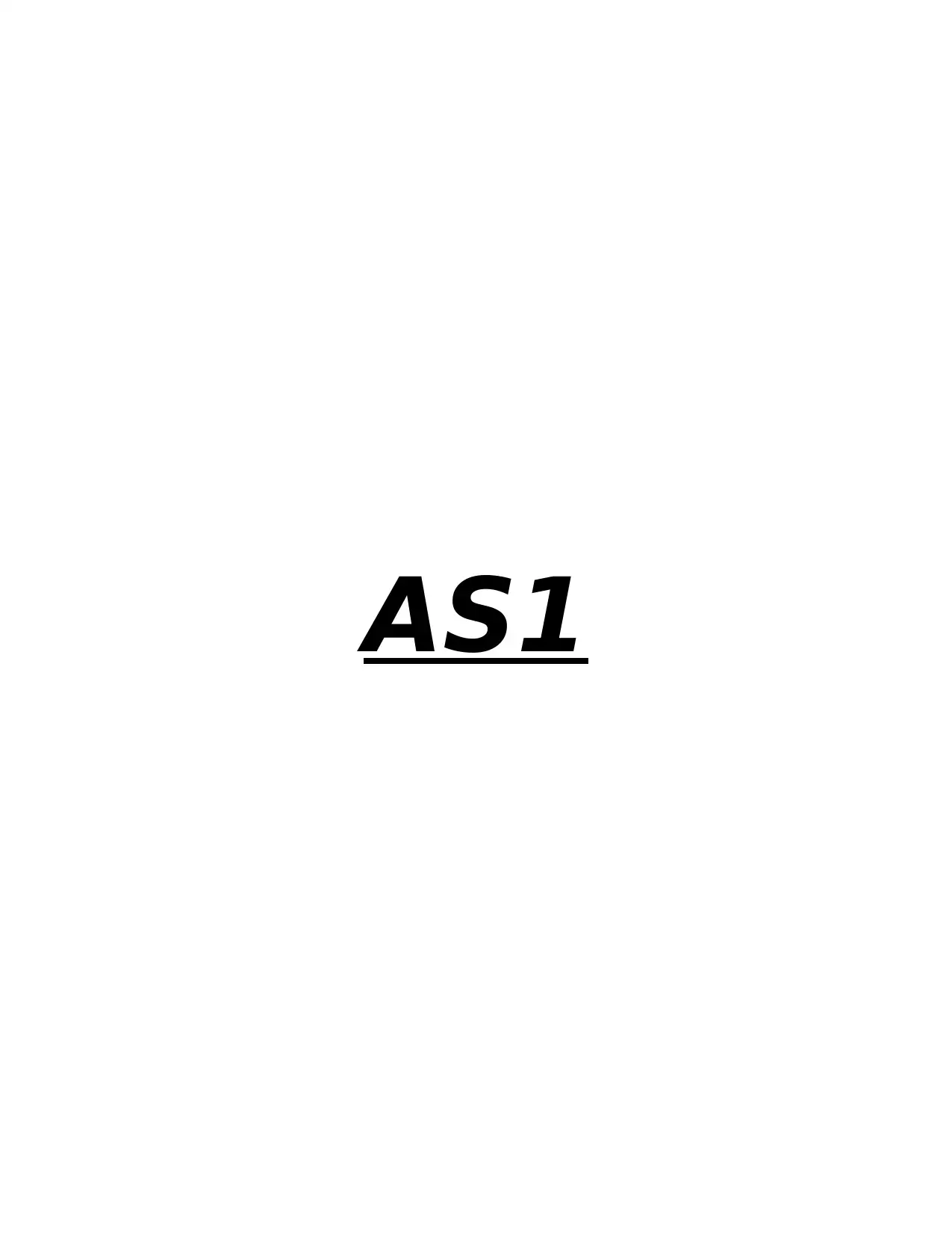
AS1
Paraphrase This Document
Need a fresh take? Get an instant paraphrase of this document with our AI Paraphraser
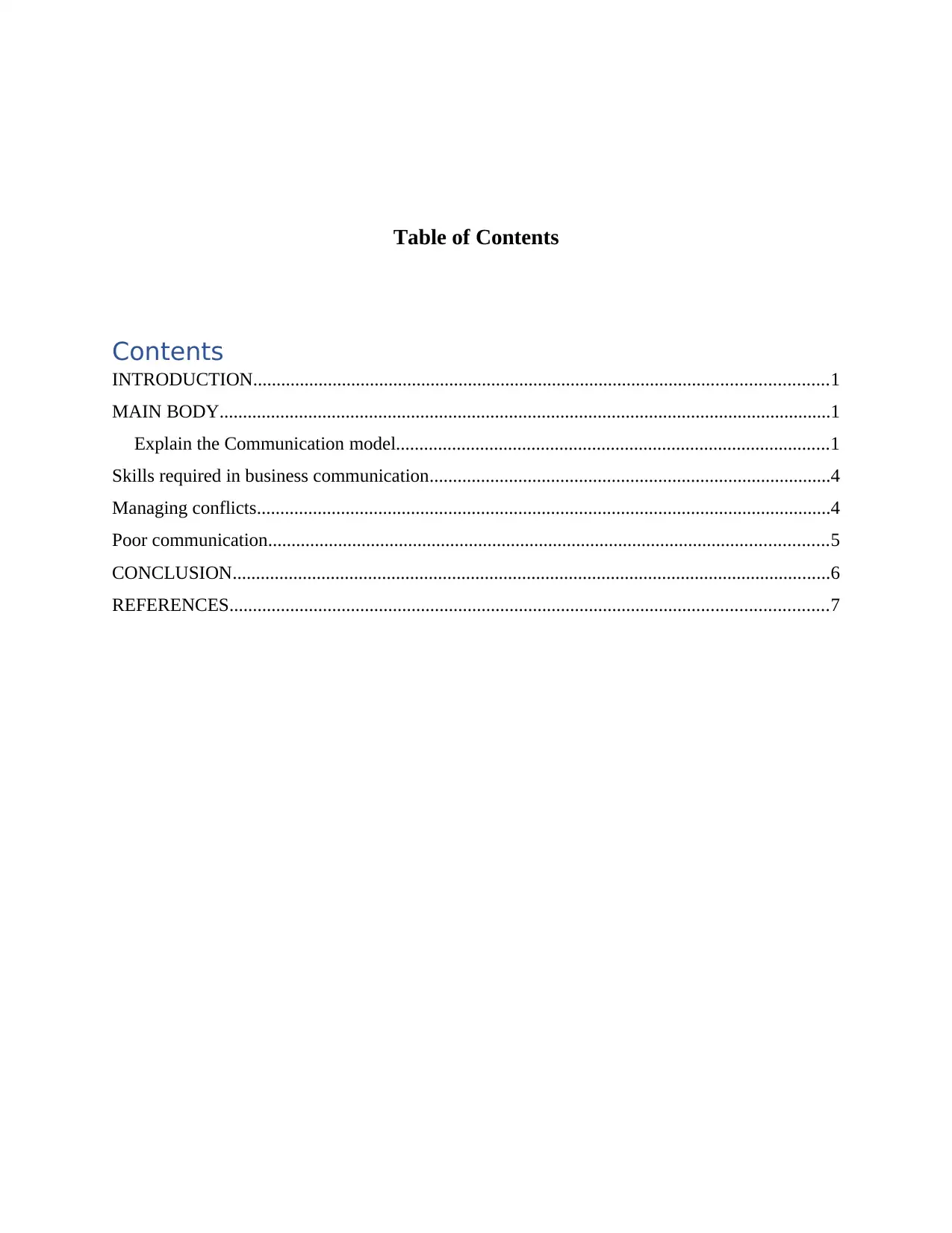
Table of Contents
Contents
INTRODUCTION...........................................................................................................................1
MAIN BODY...................................................................................................................................1
Explain the Communication model.............................................................................................1
Skills required in business communication......................................................................................4
Managing conflicts...........................................................................................................................4
Poor communication........................................................................................................................5
CONCLUSION................................................................................................................................6
REFERENCES................................................................................................................................7
Contents
INTRODUCTION...........................................................................................................................1
MAIN BODY...................................................................................................................................1
Explain the Communication model.............................................................................................1
Skills required in business communication......................................................................................4
Managing conflicts...........................................................................................................................4
Poor communication........................................................................................................................5
CONCLUSION................................................................................................................................6
REFERENCES................................................................................................................................7

INTRODUCTION
Communication is the act of giving receiving and sharing of the information, the
communication can be in written or the oral form. It is very important aspect for an individual or
the group of individuals. Communication is considered as an important skill in the environment
with the human interactions. It plays a vital role in the workplace, as there is need of good
communication for the activities that take place in an organisation and for the success of the
business enterprise. The misunderstanding in the communication can lead to the conflicts
between two individuals. It can be anywhere whether in family, friends or the
workplace(Schement, 2017). This report will include the communication mode, types of
communications, its methods, skills required in the communication, managing conflicts, poor
communication and its factors with the recommendation.
MAIN BODY
Explain the Communication model
There is various business communication model which is discussed below:
Linear communication model- The first theoretical version of conversation turned into
proposed in 1949 through Shannon and Weaver for Bell Laboratories. This three-element model
became supposed to seize the radio and tv transmission procedure. However, it changed into later
adapted to human communique and is now known as the linear version of communication. The
first a part of the model is the sender, and that is the person that is speaking. The 2d part of the
model is the channel, that's the equipment for wearing the message. The third part of the version
is the receiver, and this is the person that picks up the message. In this version, communication is
seen as a one-manner method of transmitting a message from one individual to any other person.
This version may be determined.
Transactional model- Models of communication have evolved significantly since Shannon and
Weaver first proposed their well- known conceptual model over sixty years ago. One of the most
useful models for understanding public speaking is Barnlund’s transactional model of
communication. In the transactional model, communication is seen as an ongoing, circular
process. We are constantly affecting and are affected by those we communicate with. The
1
Communication is the act of giving receiving and sharing of the information, the
communication can be in written or the oral form. It is very important aspect for an individual or
the group of individuals. Communication is considered as an important skill in the environment
with the human interactions. It plays a vital role in the workplace, as there is need of good
communication for the activities that take place in an organisation and for the success of the
business enterprise. The misunderstanding in the communication can lead to the conflicts
between two individuals. It can be anywhere whether in family, friends or the
workplace(Schement, 2017). This report will include the communication mode, types of
communications, its methods, skills required in the communication, managing conflicts, poor
communication and its factors with the recommendation.
MAIN BODY
Explain the Communication model
There is various business communication model which is discussed below:
Linear communication model- The first theoretical version of conversation turned into
proposed in 1949 through Shannon and Weaver for Bell Laboratories. This three-element model
became supposed to seize the radio and tv transmission procedure. However, it changed into later
adapted to human communique and is now known as the linear version of communication. The
first a part of the model is the sender, and that is the person that is speaking. The 2d part of the
model is the channel, that's the equipment for wearing the message. The third part of the version
is the receiver, and this is the person that picks up the message. In this version, communication is
seen as a one-manner method of transmitting a message from one individual to any other person.
This version may be determined.
Transactional model- Models of communication have evolved significantly since Shannon and
Weaver first proposed their well- known conceptual model over sixty years ago. One of the most
useful models for understanding public speaking is Barnlund’s transactional model of
communication. In the transactional model, communication is seen as an ongoing, circular
process. We are constantly affecting and are affected by those we communicate with. The
1
⊘ This is a preview!⊘
Do you want full access?
Subscribe today to unlock all pages.

Trusted by 1+ million students worldwide
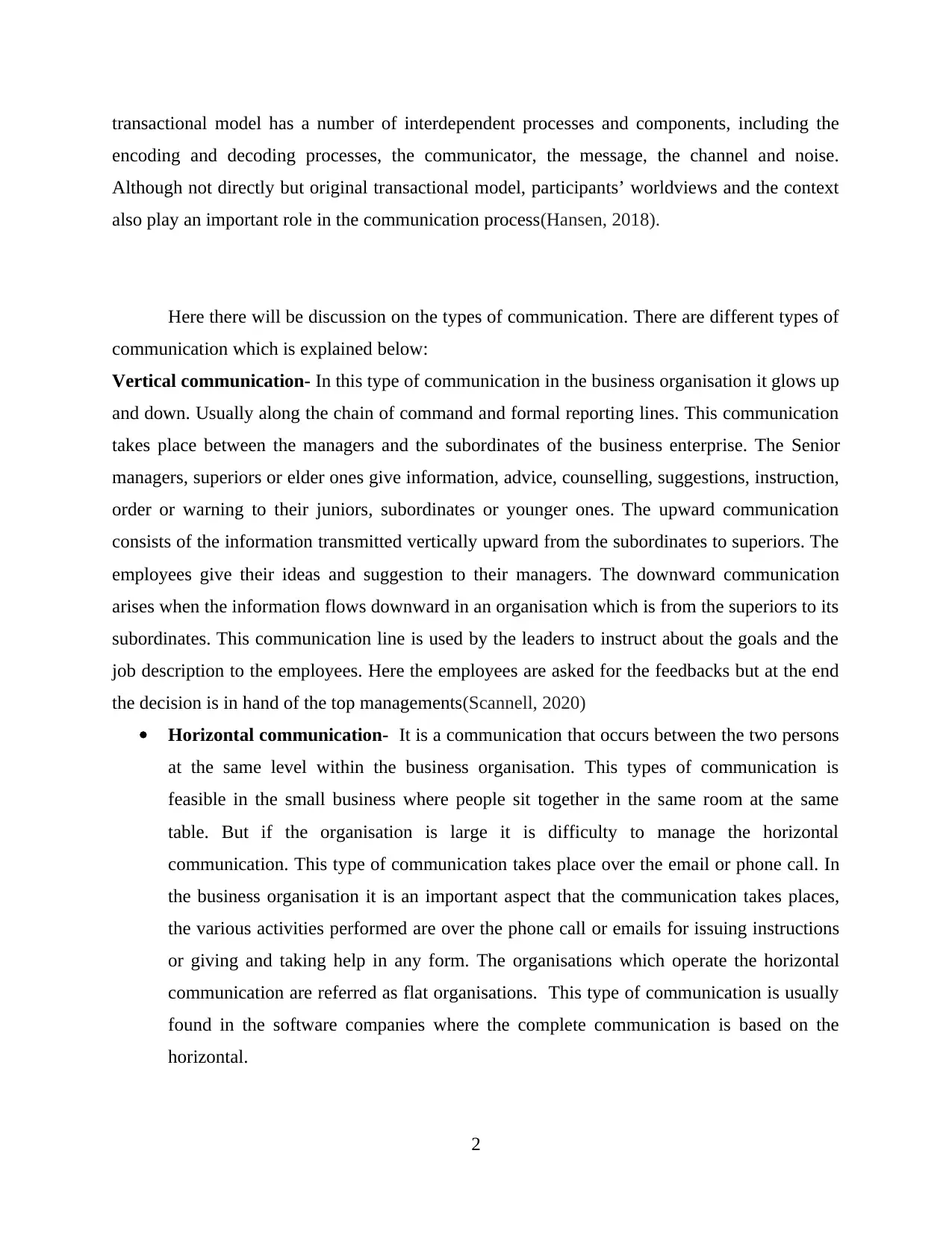
transactional model has a number of interdependent processes and components, including the
encoding and decoding processes, the communicator, the message, the channel and noise.
Although not directly but original transactional model, participants’ worldviews and the context
also play an important role in the communication process(Hansen, 2018).
Here there will be discussion on the types of communication. There are different types of
communication which is explained below:
Vertical communication- In this type of communication in the business organisation it glows up
and down. Usually along the chain of command and formal reporting lines. This communication
takes place between the managers and the subordinates of the business enterprise. The Senior
managers, superiors or elder ones give information, advice, counselling, suggestions, instruction,
order or warning to their juniors, subordinates or younger ones. The upward communication
consists of the information transmitted vertically upward from the subordinates to superiors. The
employees give their ideas and suggestion to their managers. The downward communication
arises when the information flows downward in an organisation which is from the superiors to its
subordinates. This communication line is used by the leaders to instruct about the goals and the
job description to the employees. Here the employees are asked for the feedbacks but at the end
the decision is in hand of the top managements(Scannell, 2020)
Horizontal communication- It is a communication that occurs between the two persons
at the same level within the business organisation. This types of communication is
feasible in the small business where people sit together in the same room at the same
table. But if the organisation is large it is difficulty to manage the horizontal
communication. This type of communication takes place over the email or phone call. In
the business organisation it is an important aspect that the communication takes places,
the various activities performed are over the phone call or emails for issuing instructions
or giving and taking help in any form. The organisations which operate the horizontal
communication are referred as flat organisations. This type of communication is usually
found in the software companies where the complete communication is based on the
horizontal.
2
encoding and decoding processes, the communicator, the message, the channel and noise.
Although not directly but original transactional model, participants’ worldviews and the context
also play an important role in the communication process(Hansen, 2018).
Here there will be discussion on the types of communication. There are different types of
communication which is explained below:
Vertical communication- In this type of communication in the business organisation it glows up
and down. Usually along the chain of command and formal reporting lines. This communication
takes place between the managers and the subordinates of the business enterprise. The Senior
managers, superiors or elder ones give information, advice, counselling, suggestions, instruction,
order or warning to their juniors, subordinates or younger ones. The upward communication
consists of the information transmitted vertically upward from the subordinates to superiors. The
employees give their ideas and suggestion to their managers. The downward communication
arises when the information flows downward in an organisation which is from the superiors to its
subordinates. This communication line is used by the leaders to instruct about the goals and the
job description to the employees. Here the employees are asked for the feedbacks but at the end
the decision is in hand of the top managements(Scannell, 2020)
Horizontal communication- It is a communication that occurs between the two persons
at the same level within the business organisation. This types of communication is
feasible in the small business where people sit together in the same room at the same
table. But if the organisation is large it is difficulty to manage the horizontal
communication. This type of communication takes place over the email or phone call. In
the business organisation it is an important aspect that the communication takes places,
the various activities performed are over the phone call or emails for issuing instructions
or giving and taking help in any form. The organisations which operate the horizontal
communication are referred as flat organisations. This type of communication is usually
found in the software companies where the complete communication is based on the
horizontal.
2
Paraphrase This Document
Need a fresh take? Get an instant paraphrase of this document with our AI Paraphraser
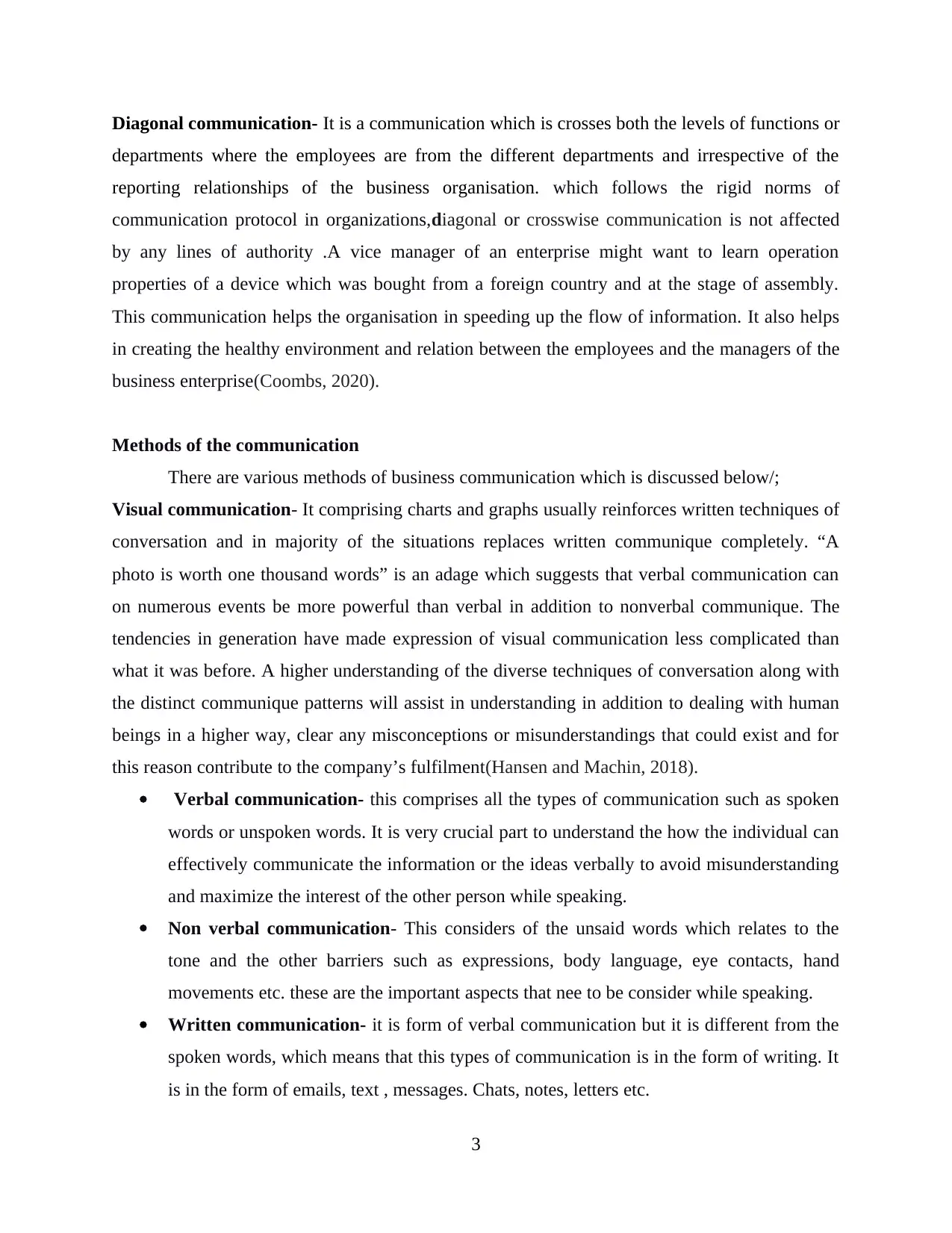
Diagonal communication- It is a communication which is crosses both the levels of functions or
departments where the employees are from the different departments and irrespective of the
reporting relationships of the business organisation. which follows the rigid norms of
communication protocol in organizations,diagonal or crosswise communication is not affected
by any lines of authority .A vice manager of an enterprise might want to learn operation
properties of a device which was bought from a foreign country and at the stage of assembly.
This communication helps the organisation in speeding up the flow of information. It also helps
in creating the healthy environment and relation between the employees and the managers of the
business enterprise(Coombs, 2020).
Methods of the communication
There are various methods of business communication which is discussed below/;
Visual communication- It comprising charts and graphs usually reinforces written techniques of
conversation and in majority of the situations replaces written communique completely. “A
photo is worth one thousand words” is an adage which suggests that verbal communication can
on numerous events be more powerful than verbal in addition to nonverbal communique. The
tendencies in generation have made expression of visual communication less complicated than
what it was before. A higher understanding of the diverse techniques of conversation along with
the distinct communique patterns will assist in understanding in addition to dealing with human
beings in a higher way, clear any misconceptions or misunderstandings that could exist and for
this reason contribute to the company’s fulfilment(Hansen and Machin, 2018).
Verbal communication- this comprises all the types of communication such as spoken
words or unspoken words. It is very crucial part to understand the how the individual can
effectively communicate the information or the ideas verbally to avoid misunderstanding
and maximize the interest of the other person while speaking.
Non verbal communication- This considers of the unsaid words which relates to the
tone and the other barriers such as expressions, body language, eye contacts, hand
movements etc. these are the important aspects that nee to be consider while speaking.
Written communication- it is form of verbal communication but it is different from the
spoken words, which means that this types of communication is in the form of writing. It
is in the form of emails, text , messages. Chats, notes, letters etc.
3
departments where the employees are from the different departments and irrespective of the
reporting relationships of the business organisation. which follows the rigid norms of
communication protocol in organizations,diagonal or crosswise communication is not affected
by any lines of authority .A vice manager of an enterprise might want to learn operation
properties of a device which was bought from a foreign country and at the stage of assembly.
This communication helps the organisation in speeding up the flow of information. It also helps
in creating the healthy environment and relation between the employees and the managers of the
business enterprise(Coombs, 2020).
Methods of the communication
There are various methods of business communication which is discussed below/;
Visual communication- It comprising charts and graphs usually reinforces written techniques of
conversation and in majority of the situations replaces written communique completely. “A
photo is worth one thousand words” is an adage which suggests that verbal communication can
on numerous events be more powerful than verbal in addition to nonverbal communique. The
tendencies in generation have made expression of visual communication less complicated than
what it was before. A higher understanding of the diverse techniques of conversation along with
the distinct communique patterns will assist in understanding in addition to dealing with human
beings in a higher way, clear any misconceptions or misunderstandings that could exist and for
this reason contribute to the company’s fulfilment(Hansen and Machin, 2018).
Verbal communication- this comprises all the types of communication such as spoken
words or unspoken words. It is very crucial part to understand the how the individual can
effectively communicate the information or the ideas verbally to avoid misunderstanding
and maximize the interest of the other person while speaking.
Non verbal communication- This considers of the unsaid words which relates to the
tone and the other barriers such as expressions, body language, eye contacts, hand
movements etc. these are the important aspects that nee to be consider while speaking.
Written communication- it is form of verbal communication but it is different from the
spoken words, which means that this types of communication is in the form of writing. It
is in the form of emails, text , messages. Chats, notes, letters etc.
3

Skills required in business communication
There are various types of skills which is required in the business communication. It is
the important aspect in the business organisation so that the people understand each other in the
better way and can communicate with each other in relation to the activities which need to be
performed.
Writing skill- Using precise facts and examples in written communication to make a solid case,
and speaking proposed action objects. Written conversation for enterprise must be quick
however informative, and facilitates an audience focus on simplest the maximum essential
points. Good written verbal exchange additionally consists of ok comply with-up, which closes
the conversation loop and indicates proactive pastime towards goals(Lowenthal, 2017)
Listening skill- The capacity to concentrate to and comprise other views to your communication.
Listening suggests you fee evaluations outdoor of your very own and are open to new principles.
As a result, your target market views you as a same associate and you may come to an answer
that advantages the more top. An lively listener will permit pauses for interjections, repeat
different individuals words and ask inquiries to verify his or her engagement in a verbal
exchange.
Body language- The capability to pay attention to and comprise other perspectives to your
communication. Listening shows you fee evaluations outside of your very personal and are open
to new principles. As a end result, your target market views you as an identical associate and you
could come to a solution that benefits the more top. An energetic listener will permit pauses for
interjections, repeat specific people’s words and ask inquiries to verify his or her engagement in
a communique(Freelon, and Wells 2020).
4
There are various types of skills which is required in the business communication. It is
the important aspect in the business organisation so that the people understand each other in the
better way and can communicate with each other in relation to the activities which need to be
performed.
Writing skill- Using precise facts and examples in written communication to make a solid case,
and speaking proposed action objects. Written conversation for enterprise must be quick
however informative, and facilitates an audience focus on simplest the maximum essential
points. Good written verbal exchange additionally consists of ok comply with-up, which closes
the conversation loop and indicates proactive pastime towards goals(Lowenthal, 2017)
Listening skill- The capacity to concentrate to and comprise other views to your communication.
Listening suggests you fee evaluations outdoor of your very own and are open to new principles.
As a result, your target market views you as a same associate and you may come to an answer
that advantages the more top. An lively listener will permit pauses for interjections, repeat
different individuals words and ask inquiries to verify his or her engagement in a verbal
exchange.
Body language- The capability to pay attention to and comprise other perspectives to your
communication. Listening shows you fee evaluations outside of your very personal and are open
to new principles. As a end result, your target market views you as an identical associate and you
could come to a solution that benefits the more top. An energetic listener will permit pauses for
interjections, repeat specific people’s words and ask inquiries to verify his or her engagement in
a communique(Freelon, and Wells 2020).
4
⊘ This is a preview!⊘
Do you want full access?
Subscribe today to unlock all pages.

Trusted by 1+ million students worldwide

Managing conflicts
Workplace refers to the area where different people come together to achieve the organisational
goals and their own personal goals. People of distinguished backgrounds have their own way of
working and communicating. Due to this workplace conflicts are bound to happen. Managing
conflicts at workplace is an important aspect in the organisation as these are required to avoid the
negative consequences that may arise due to disagreements at the workplace. These conflicts can
occur due to many reasons, some of them are, communication factor, structural factors or
personal factors.
Communication factors include the communication barriers that are present in the organisation
due to poor listening skills or wrong interpretation of the information. Structural factors includes
the factors like the size of the team and not having clear understanding of the functional relations
among the superior- subordinates. Personal factors include the individual factors like self esteem,
personal values and needs of the employees (Tufte, 2017).
Poor communication
Organisation is all about managing and understanding the other employees working in the
organisation. Poor communication occurs when the what is being communicated is either
understood wrongly or communicated wrong information. The ultimate impact of this is that the
company may face this as a cost either in efficiency or efficacy in the working. In simple words
the poor communication is when the person who is being communicated, does not understand the
information which was communicated to them. This can be seen a lot of times in an organisation.
Organisation needs to address such issues as these can create a potential threat in the
organisation in long run. One of the cause of this issue is tone. Tone refers to the way a person
communicates the information. Tone is an important factor in communication as it impacts how
the listener will grab the piece of information. For example, a superior directs its team in a way
of passive aggression due to some old foolishness that was done by the team. Due to this passive
aggression the team was not able to fully understand the task and they were not in the position to
ask questions. The performance of the team went down drastically and the goals of the
organisation were not met(Call. and Tomasello, eds., 2020).
5
Workplace refers to the area where different people come together to achieve the organisational
goals and their own personal goals. People of distinguished backgrounds have their own way of
working and communicating. Due to this workplace conflicts are bound to happen. Managing
conflicts at workplace is an important aspect in the organisation as these are required to avoid the
negative consequences that may arise due to disagreements at the workplace. These conflicts can
occur due to many reasons, some of them are, communication factor, structural factors or
personal factors.
Communication factors include the communication barriers that are present in the organisation
due to poor listening skills or wrong interpretation of the information. Structural factors includes
the factors like the size of the team and not having clear understanding of the functional relations
among the superior- subordinates. Personal factors include the individual factors like self esteem,
personal values and needs of the employees (Tufte, 2017).
Poor communication
Organisation is all about managing and understanding the other employees working in the
organisation. Poor communication occurs when the what is being communicated is either
understood wrongly or communicated wrong information. The ultimate impact of this is that the
company may face this as a cost either in efficiency or efficacy in the working. In simple words
the poor communication is when the person who is being communicated, does not understand the
information which was communicated to them. This can be seen a lot of times in an organisation.
Organisation needs to address such issues as these can create a potential threat in the
organisation in long run. One of the cause of this issue is tone. Tone refers to the way a person
communicates the information. Tone is an important factor in communication as it impacts how
the listener will grab the piece of information. For example, a superior directs its team in a way
of passive aggression due to some old foolishness that was done by the team. Due to this passive
aggression the team was not able to fully understand the task and they were not in the position to
ask questions. The performance of the team went down drastically and the goals of the
organisation were not met(Call. and Tomasello, eds., 2020).
5
Paraphrase This Document
Need a fresh take? Get an instant paraphrase of this document with our AI Paraphraser
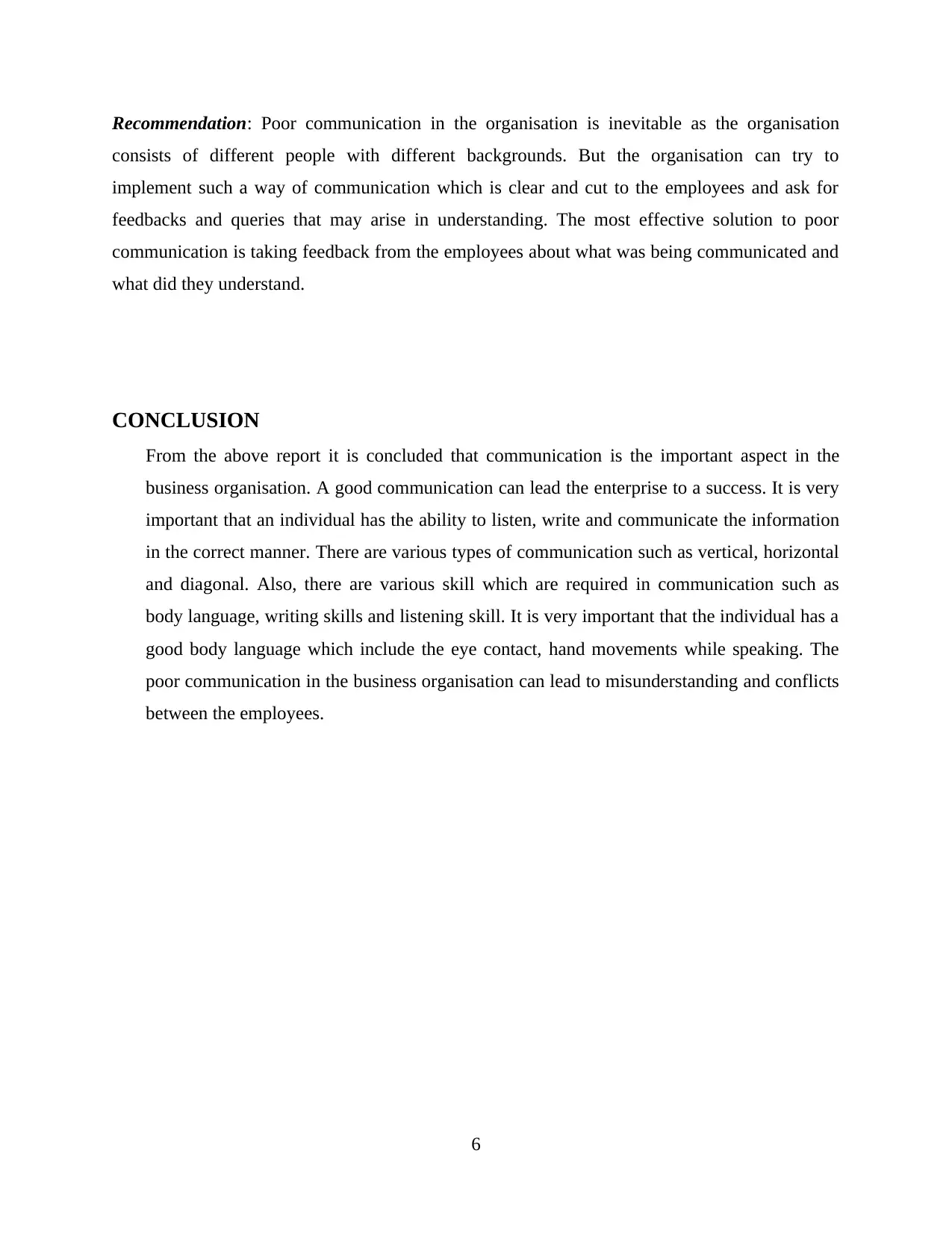
Recommendation: Poor communication in the organisation is inevitable as the organisation
consists of different people with different backgrounds. But the organisation can try to
implement such a way of communication which is clear and cut to the employees and ask for
feedbacks and queries that may arise in understanding. The most effective solution to poor
communication is taking feedback from the employees about what was being communicated and
what did they understand.
CONCLUSION
From the above report it is concluded that communication is the important aspect in the
business organisation. A good communication can lead the enterprise to a success. It is very
important that an individual has the ability to listen, write and communicate the information
in the correct manner. There are various types of communication such as vertical, horizontal
and diagonal. Also, there are various skill which are required in communication such as
body language, writing skills and listening skill. It is very important that the individual has a
good body language which include the eye contact, hand movements while speaking. The
poor communication in the business organisation can lead to misunderstanding and conflicts
between the employees.
6
consists of different people with different backgrounds. But the organisation can try to
implement such a way of communication which is clear and cut to the employees and ask for
feedbacks and queries that may arise in understanding. The most effective solution to poor
communication is taking feedback from the employees about what was being communicated and
what did they understand.
CONCLUSION
From the above report it is concluded that communication is the important aspect in the
business organisation. A good communication can lead the enterprise to a success. It is very
important that an individual has the ability to listen, write and communicate the information
in the correct manner. There are various types of communication such as vertical, horizontal
and diagonal. Also, there are various skill which are required in communication such as
body language, writing skills and listening skill. It is very important that the individual has a
good body language which include the eye contact, hand movements while speaking. The
poor communication in the business organisation can lead to misunderstanding and conflicts
between the employees.
6

7
⊘ This is a preview!⊘
Do you want full access?
Subscribe today to unlock all pages.

Trusted by 1+ million students worldwide
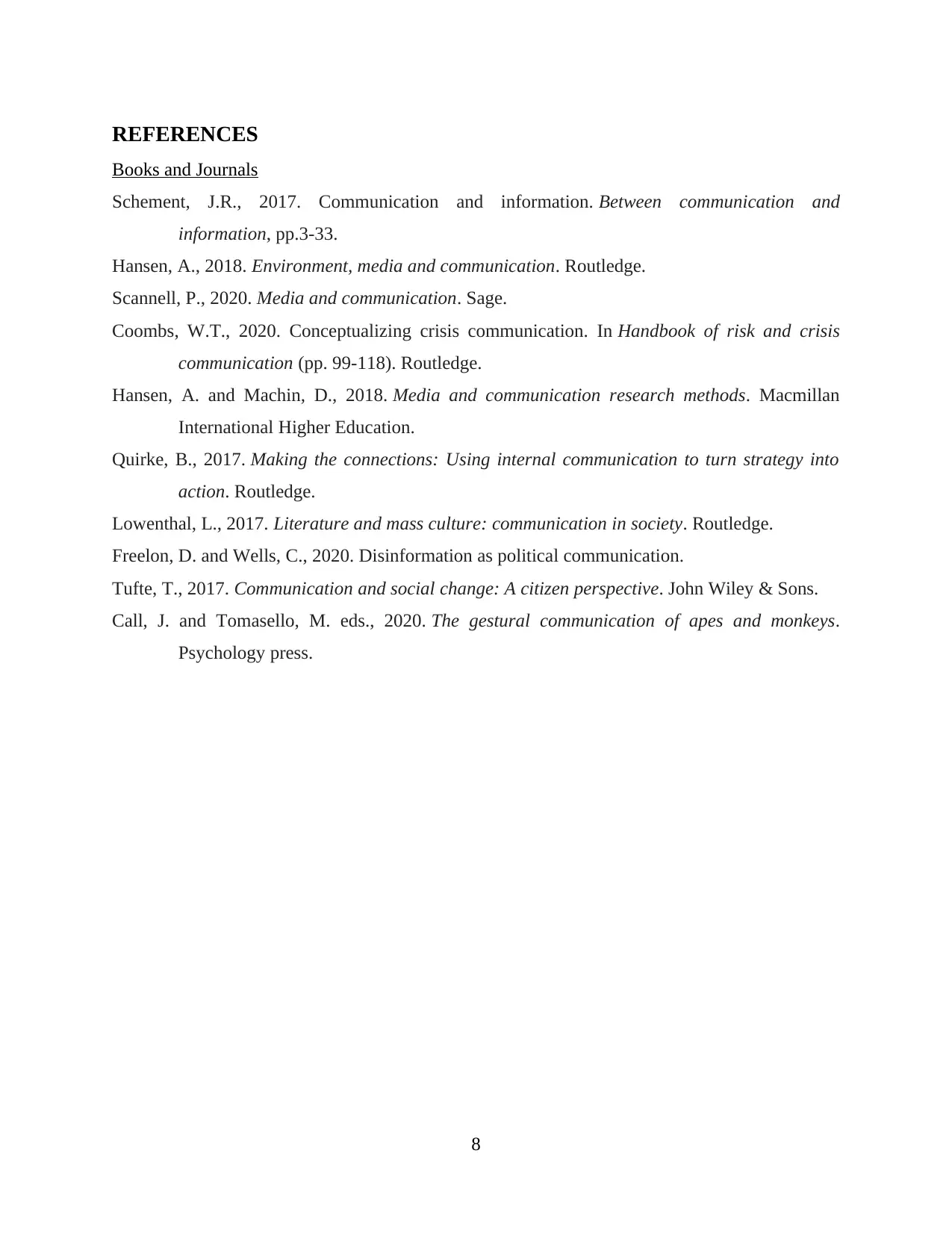
REFERENCES
Books and Journals
Schement, J.R., 2017. Communication and information. Between communication and
information, pp.3-33.
Hansen, A., 2018. Environment, media and communication. Routledge.
Scannell, P., 2020. Media and communication. Sage.
Coombs, W.T., 2020. Conceptualizing crisis communication. In Handbook of risk and crisis
communication (pp. 99-118). Routledge.
Hansen, A. and Machin, D., 2018. Media and communication research methods. Macmillan
International Higher Education.
Quirke, B., 2017. Making the connections: Using internal communication to turn strategy into
action. Routledge.
Lowenthal, L., 2017. Literature and mass culture: communication in society. Routledge.
Freelon, D. and Wells, C., 2020. Disinformation as political communication.
Tufte, T., 2017. Communication and social change: A citizen perspective. John Wiley & Sons.
Call, J. and Tomasello, M. eds., 2020. The gestural communication of apes and monkeys.
Psychology press.
8
Books and Journals
Schement, J.R., 2017. Communication and information. Between communication and
information, pp.3-33.
Hansen, A., 2018. Environment, media and communication. Routledge.
Scannell, P., 2020. Media and communication. Sage.
Coombs, W.T., 2020. Conceptualizing crisis communication. In Handbook of risk and crisis
communication (pp. 99-118). Routledge.
Hansen, A. and Machin, D., 2018. Media and communication research methods. Macmillan
International Higher Education.
Quirke, B., 2017. Making the connections: Using internal communication to turn strategy into
action. Routledge.
Lowenthal, L., 2017. Literature and mass culture: communication in society. Routledge.
Freelon, D. and Wells, C., 2020. Disinformation as political communication.
Tufte, T., 2017. Communication and social change: A citizen perspective. John Wiley & Sons.
Call, J. and Tomasello, M. eds., 2020. The gestural communication of apes and monkeys.
Psychology press.
8
1 out of 10
Related Documents
Your All-in-One AI-Powered Toolkit for Academic Success.
+13062052269
info@desklib.com
Available 24*7 on WhatsApp / Email
![[object Object]](/_next/static/media/star-bottom.7253800d.svg)
Unlock your academic potential
Copyright © 2020–2025 A2Z Services. All Rights Reserved. Developed and managed by ZUCOL.



